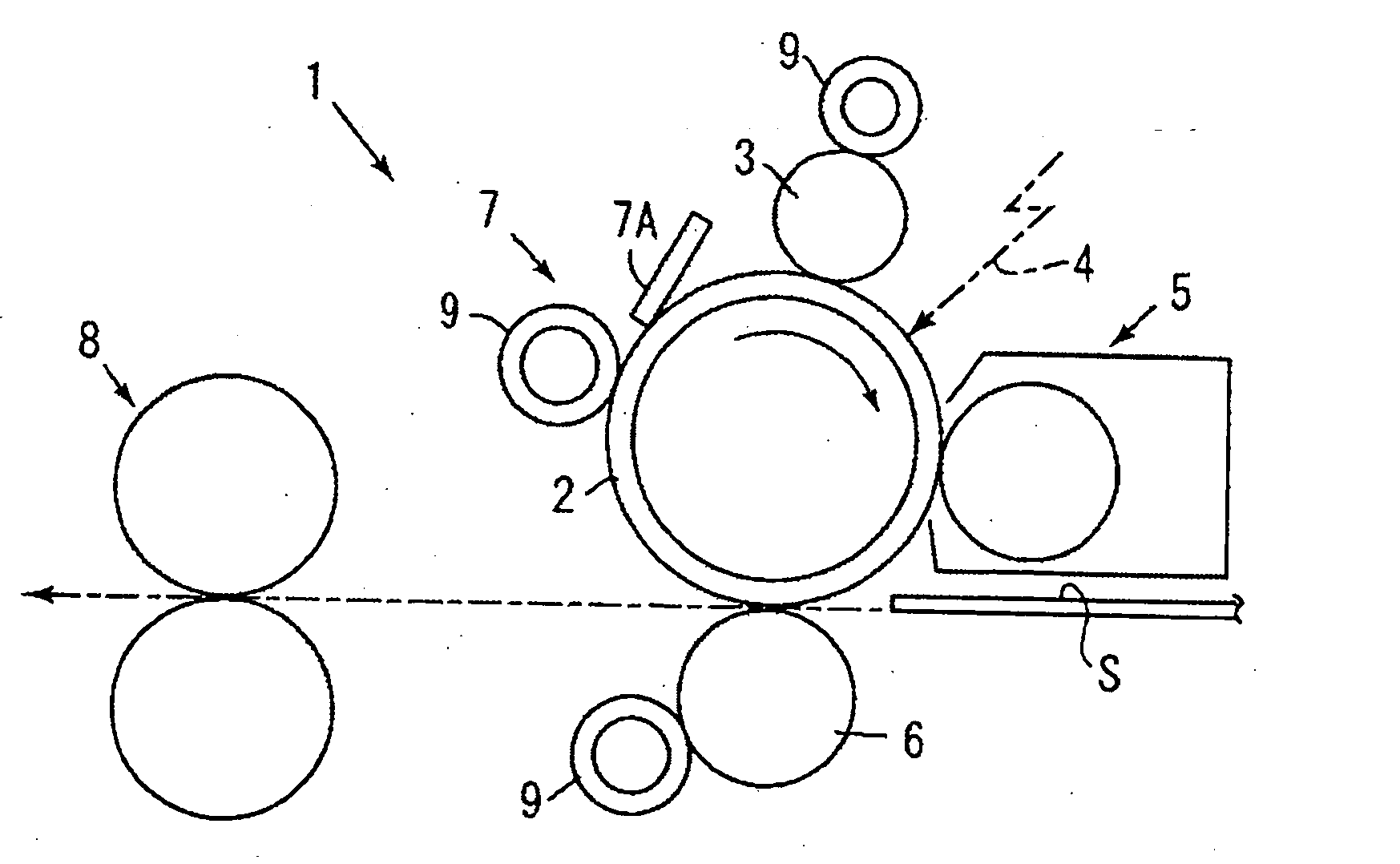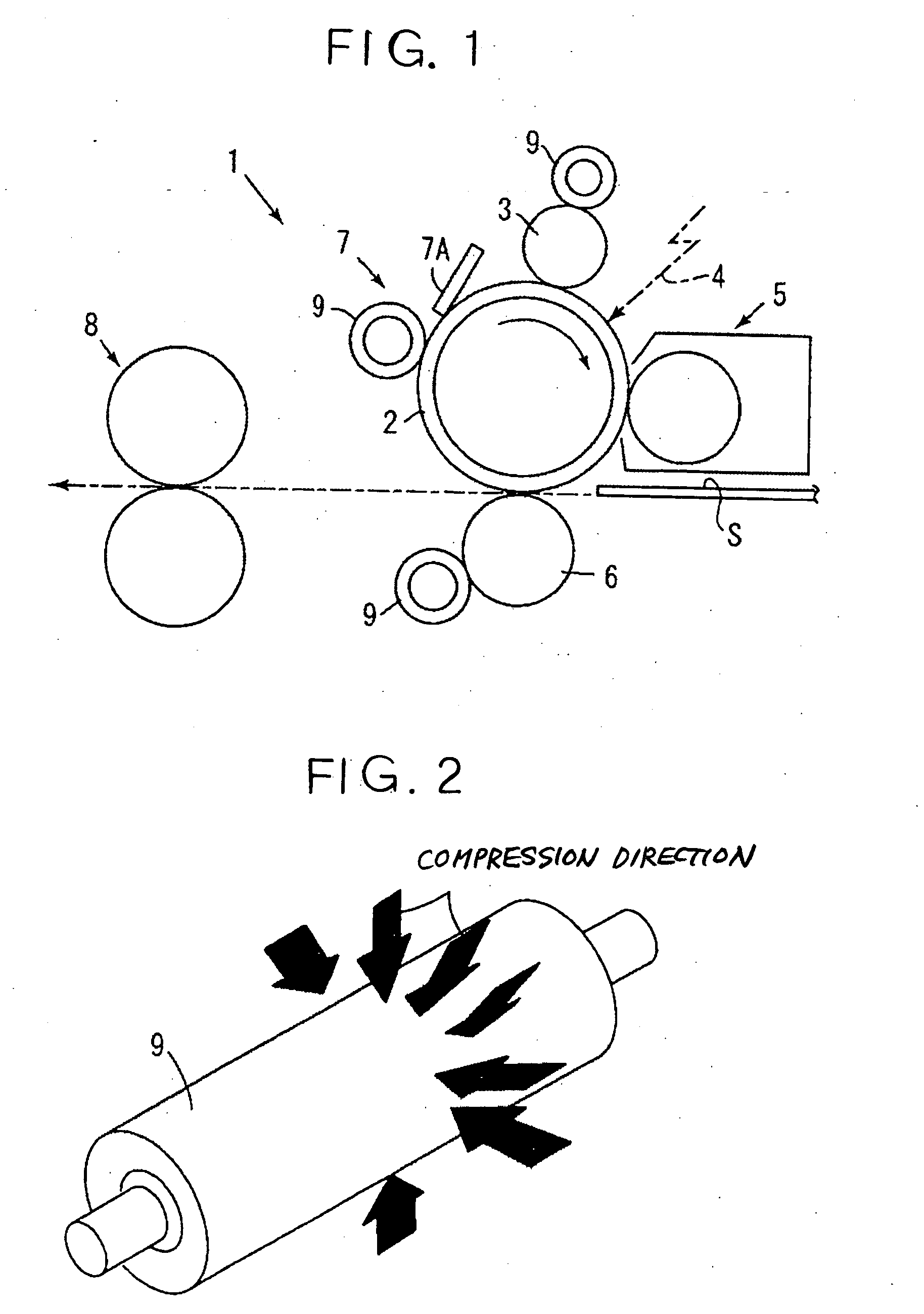Charged device, cleaning device, process cartridge, toner, and image-forming device that uses these
a technology of image-forming device and charge device, which is applied in the direction of electrographic process apparatus, discharge of corona, instruments, etc., can solve the problems of image quality decline, charging characteristics can deteriorate, and charge characteristics can deteriorate, so as to prevent the image quality from deteriorating, increase the cost, and prevent the effect of the charged state deteriorating
- Summary
- Abstract
- Description
- Claims
- Application Information
AI Technical Summary
Benefits of technology
Problems solved by technology
Method used
Image
Examples
first embodiment
[0065] The present embodiment is designed to achieve the first object of the present invention described above.
[0066]FIG. 1 shows the configuration of an image-forming device in which the cleaning device according to the present embodiment has been applied, and the image-forming device 1 shown in the diagram is provided with a photoreceptor 2 in the form of a drum (hereinafter referred to as “photoreceptor drum”) as a latent image carrier. Disposed around the photoreceptor drum 2 are a charged device 3 for carrying out an image formation routine along the direction of rotation (direction of the arrow in the diagram) of the drum 2, a writing device (only the optical path is shown) 4, a developing device 5, a transfer device 6, and a cleaning device 7.
[0067] In the image-forming device 1 shown in FIG. 1, a uniform charge is created by the charged device 3 during the rotation of the photoreceptor drum 2, an electrostatic latent image is then formed by the writing device 4 in correspo...
second embodiment
[0099]FIG. 4 is a diagram showing the general configuration of the first concrete example of the image-forming device according to the present embodiment, and FIG. 5 is a diagram showing the general configuration of the photoreceptor unit.
[0100] The image-forming device is provided with four image-forming units 1Y, 1M, 1C, and 1K for forming images in each of the colors yellow (Y), magenta (M), cyan (C), and black (K). Is should be noted that the sequence of the colors Y, M, C, and K is not limited to FIG. 1, and other color sequences are possible.
[0101] The image-forming units 1Y, 1M, 1C, and 1K are provided with photoreceptor drums 11Y, 11M, 11C, and 11K, respectively, as image carriers, as well as with a charged device, a developing device, and a cleaning device. Also, the image-forming units 1Y, 1M, 1C, and 1K are arranged so as to be parallel to the axis of rotation of the photoreceptor drum and be arrayed at a prescribed pitch in the movement direction of the transfer paper....
third embodiment
[0201] Described below is an embodiment in which the present invention has been applied to a color laser printer (hereinafter simply referred to as “printer”), which is an image-forming device.
[0202]FIG. 15 is a diagram of the general configuration of the printer according to the present embodiment. The printer is configured with a tandem image-forming unit in which four image-forming devices for the colors yellow, cyan, magenta, and black are aligned in a lateral arrangement. In the tandem image-forming units, the image-forming devices 101Y, 101C, 101M, and 101K, which are each toner image-forming devices, are disposed in order from the left side of the diagram. Here, each of the subscripts of the key symbols Y, C, M, and K represent members for yellow, magenta, cyan, and black, respectively. In the tandem image-forming device unit, the image-forming devices 101Y, C, M, and K are provided with a charged device, developing devices 10Y, C, M, and K, a photoreceptor cleaning device, ...
PUM
 Login to View More
Login to View More Abstract
Description
Claims
Application Information
 Login to View More
Login to View More - R&D
- Intellectual Property
- Life Sciences
- Materials
- Tech Scout
- Unparalleled Data Quality
- Higher Quality Content
- 60% Fewer Hallucinations
Browse by: Latest US Patents, China's latest patents, Technical Efficacy Thesaurus, Application Domain, Technology Topic, Popular Technical Reports.
© 2025 PatSnap. All rights reserved.Legal|Privacy policy|Modern Slavery Act Transparency Statement|Sitemap|About US| Contact US: help@patsnap.com



